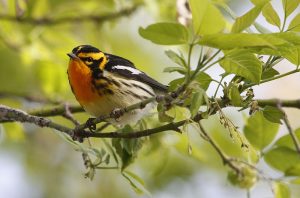
Native Plantings to Attract Migratory Birds
After a little good-natured group tribute to Doug Tallamy, Judy Pollock told us about the real conservation work we can do. Where? Not in faraway places at all but simply in our own yards. In Judy’s own yard in Evanston, IL, she has observed 125 migratory species in her yard, and she thinks that if any of us begin to really look and of course plant things these birds prefer, we would see the same number. Her yard is filled with native shrubs and trees which birds need.
Why we should plant for migratory species?
Birds that fly up from the south go through a corn and soybean desert in the middle section of IL where almost all of the land is agricultural and little resources are there for them. Once they get to the Chicago region, they get a real respite from the demands of migration on little fuel/shelter.
Judy referred to a study by Doug Stotz in which he found that most of the species that visited Thatcher Woods could also be found in the neighboring yards. This means that our yards can definitely do a lot of good and act almost as well as a woodlands can for these birds. Studies about the impact of yards on bird populations continue as in this recent study: Backyards for Birds
Judy’s 3 Main Landscaping for Birds Principles
- Layered plantings–think upper canopy with trees, understory smaller trees, shrubs, then the ground layer
- Diversity of species to offer plenty and variation in leaf-out, berries, seeds during migratory seasons (spring–April-May; fall–Sept-Oct)
- Density of vegetation–birds need dense and complex structure
Most effective trees for the Chicago region:
Elms, Oaks, Hackberries, Hawthornes, Walnuts, Hickories, Crabapples, and Black Cherry trees attract the largest # of birds, due to number of caterpillars and other insects
For the nectar drinking migrants
Iowa Crab, Buckeye, Hawthorne
Bud-eating Birds
Elm buds, River Birch, Hop Hornbeam
Her recommended books:
Birdscaping in the Midwest by Mariette Nowak
Shrubs and Woody Vines of Indiana and the Midwest by Weeks and Weeks
Another resource: Mariette Nowak wrote a series of articles for Wild Ones which you can access here: Beyond the Birdfeeder
